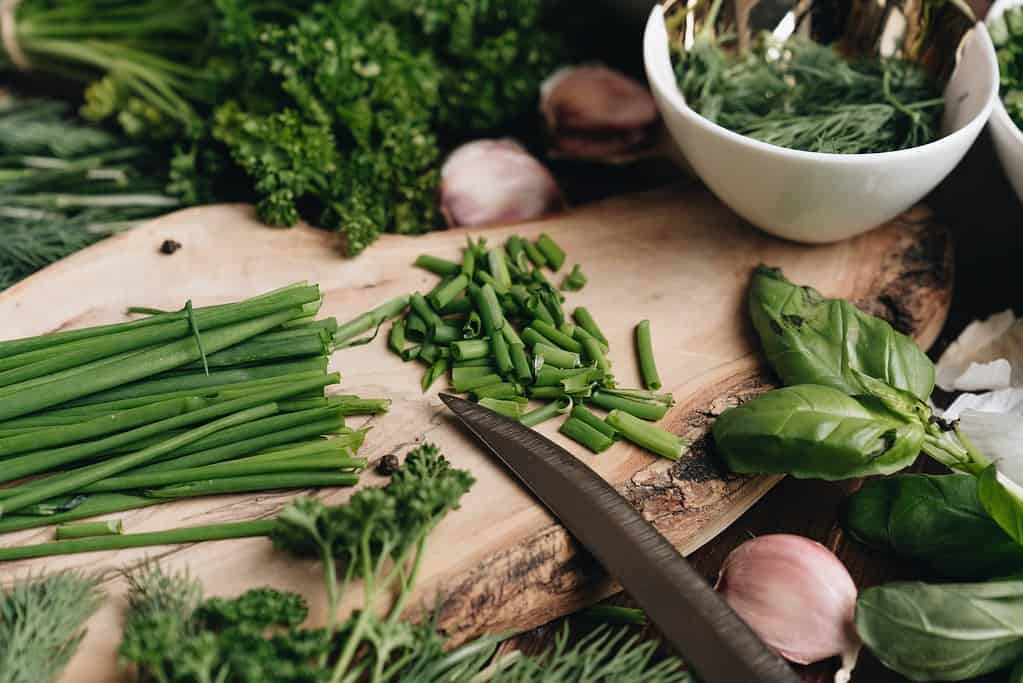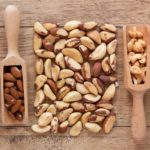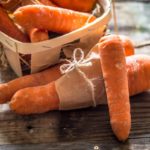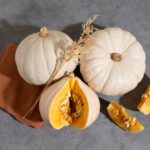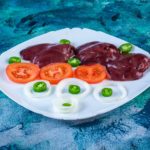
Bernadeth Atrinindarti
MAppSc (Advanced Nutrition Practice)
In many countries, herbal medicine has been widely used for thousands of years to treat various diseases.
Natural components obtained from plants, including:
- polyphenols
- flavonoids
- carotenoids
- alkaloids
are today being researched because of their biologically active and beneficial effects on conditions such as cancer.[1]
We’ll start with looking at the current research on cancer and studies that are dealing with various herbs and spices and their anti-cancer properties.
Current research on Herbs, Spices and Cancer
Research has shown that herbs and spices contain bioactive components that could promote overall health. In recent decades, there is growing evidence showing that herbs and spices also have anti-carcinogenic activities.
A systematic review found around 4,882 articles published from January 2000 to January 2020 on herbal medicine use in cancer treatment or prevention.
The studies on herbs and spices and their effect on cancer seems to be just starting since many people are looking for an alternative therapy to treat cancer.
Salvia miltiorrhiza
Salvia miltiorrhiza Bunge, also called red sage or Danshen in Chinese, is native to China and Japan.

Source: Pang, H. Chemical Analysis of the Herbal Medicine Salviae miltiorrhizae Radix et Rhizoma (Danshen). (2016)
Salvia miltiorrhiza has been used in China and other Asian countries as a traditional treatment for cardiovascular diseases including:
- atherosclerosis
- thrombosis
- angina pectoris[2]
The reason why Salvia miltiorrhiza is so interesting to researchers is due to liposoluble compound called dihydrotanshinone I (DHTS) which has been studied for its anti-cancer, anti-inflammatory, cardioprotective effects.[3]
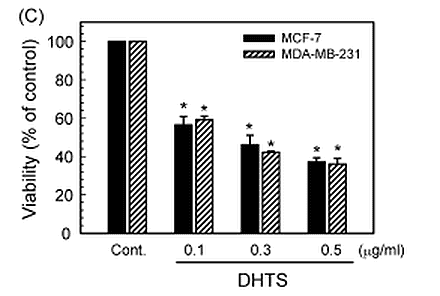
A study by Tsai et al. reported that DHTS impaired survival rate of human breast cancer cell lines, where the cancer cells were exposed to an increasing dose of DHT for 24 h.[4]
Another study observed the effect of a group of tanshinones from Salvia Milthiorrhiza including cryptotanshinone (CT), tanshinone IIA (T2A) and tanshinone I (T1) on prostate cancer.[5]
The result indicated that the tanshinones inhibit the growth of the human prostate cancer line via apoptosis (cell death) and cell cycle arrest.[5]
Scutellaria barbata

Source: Corcoran, O. From Scutellaria barbata to BZL101 in Cancer Patients: Phytochemistry, Pharmacology, and Clinical Evidence. (2019)
Scutellaria barbata D. Don (SB) is a traditional medicinal herb widely known in northeast Asia. It is often used as an anti-inflammatory and a diuretic in China.
In Traditional Chinese medicine, it is valued because of its anti-tumour activity to inhibit the growth of cancer cells.[6]
In one study ethanol extracts of Scutellaria barbata significantly inhibit cell growth of human lung cancer when the cells were treated with different concentrations ranging from 0.1 to 0.5 mg/ml for 3 days.[7]

Another study was observing the effect of Scutellaria barbata D. Don on ovarian cancer cells. The cells were exposed to increasing concentrations from 0–400 µg/mL for 24 or 48 h.
The result showed a significant decrease in the survival rate of ovarian cancer cells.[8]
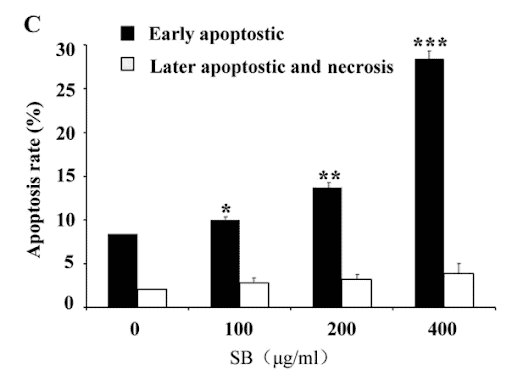
The same study also reported a gradual increase in the rate of apoptosis cells with increasing concentrations of Scutellaria barbata.[8]
Thyme
Thymus vulgaris L. or thyme is one of the traditional herbs that has therapeutic properties. It is native to Southern Europe, the Middle East and Western Asia.
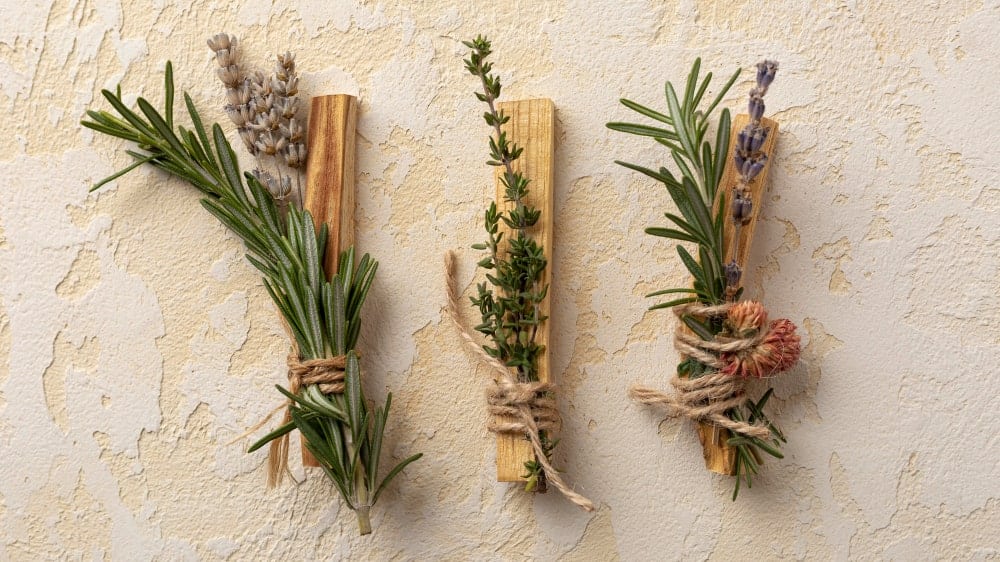
Source: FreePik
It has been used for over a thousand years as an aromatic fragrance and also to treat several conditions including back pain and sore throat.
Recent studies indicated that thyme possesses:
- antifungal
- antibacterial
- antioxidant, and
- anti-inflammatory properties
A study reported that treatment with increasing doses (0.2, 0.4, 0.6, and 0.8 mg/mL) of thyme extract could decrease the cell survival rate of human colon carcinoma cells.[9]
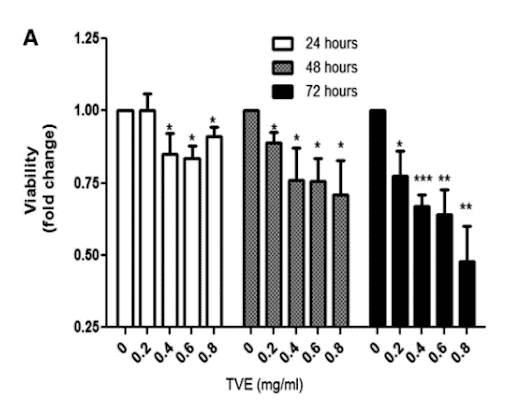
This study also indicated that thyme extract induced apoptosis or cell death in human colon carcinoma cell line.[9]
Another study was looking at the effect of thyme essential oil on human adenocarcinoma cell lines.
The result reported that thyme essential oil decreased the metabolic activity and cell survival rate.
Turmeric
Curcuma longa or turmeric has been used as a condiment, textile dye and medicine. It is native to India and Indonesia.
Turmeric is best known for its polyphenol called curcumin
Curcumin has gained popularity among scientists for its biological properties such as anti-oxidant, anti-inflammatory, anti-microbial, anti-viral and anti-cancer potential.[10]
RELATED — Turmeric (Curcuma longa)

Source: FreePik
Curcumin is considered the main cause of the yellow/golden colour of turmeric and made up 2–8% of turmeric components.
A number of studies reported that curcumin has preventive and therapeutic effects on different types of cancers.
It is known that there is a strong relationship between inflammation and cancer, therefore anti-inflammatory effects of curcumin would be able to help treat cancer.
One study reported that curcumin can inhibit cancer cell growth of human lung cancer cell lines, where lung cancer cells were exposed to various curcumin concentrations ranging from 0–100µM for 24 or 48 h.[11]
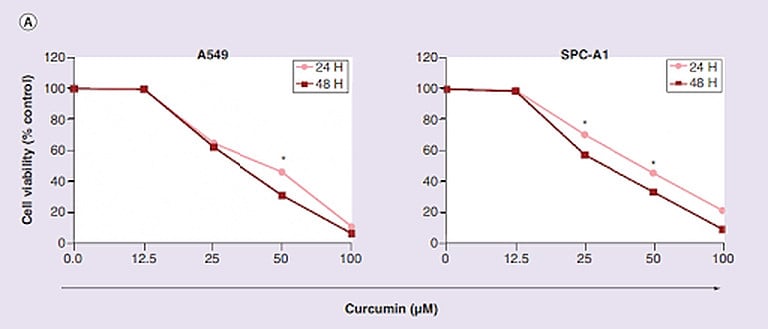
Moreover, the curcumin treatment also decreased the survival rate of cancer cells.[11]
Another study by Zhang et al. was looking at the effect of curcumin on the cell survival rate of pancreatic cancer cells. This study reported that curcumin inhibited the cell growth of pancreatic cancer cell lines.[12]
Fenugreek
Trigonella foenum-graecum or known as fenugreek is native to Mediterranean countries and Asia. Its seeds smell and taste like maple syrup and have been used in cooking and as medicine.
Fenugreek dried seed is widely known for its anti-bacterial, anti-inflammatory and anti-cancer activity in many countries including India, Egypt and some European countries.
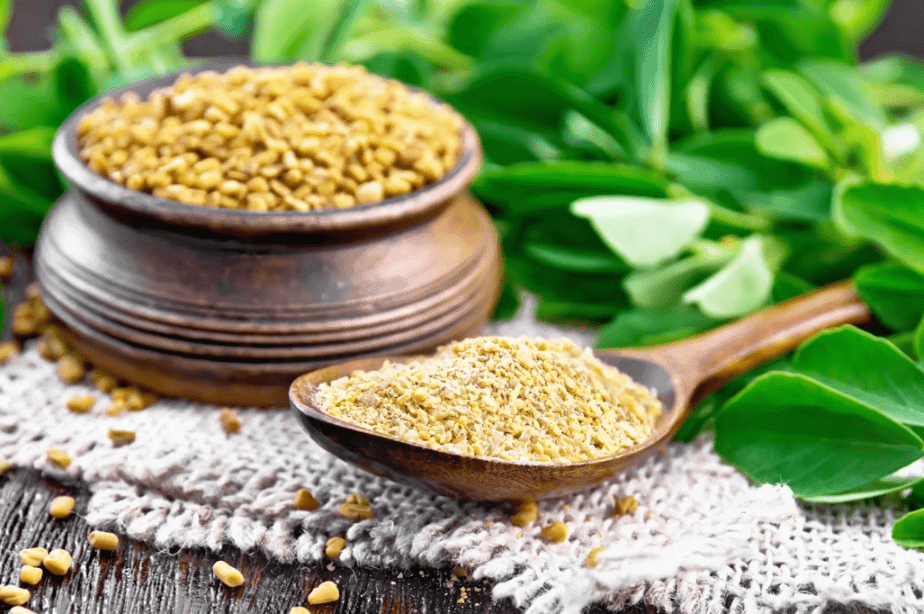
Source: Shutterstock
The major components of fenugreek are tannins, alkaloids, flavonoids, terpenoids, and glycosides which are known to have anti-microbial properties.[13]
A study by Shabbeer et al. reported that fenugreek extract significantly inhibits cell growth in breast cancer cells and pancreatic cell lines. It had a dose-dependent effect with a concentration as low as 10 ug/ml for 72 h.[14]
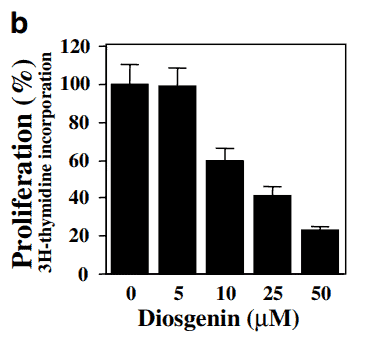
Another study by Sebastian and Thampan looked for the effect of diosgenin from fenugreek on human breast cancer cell lines.
The result reported that diosgenin decreased cell growth and induced apoptosis in cancer cells. The cancer cells were treated with an increasing dosage ranging from 0–40 µM for 72 h.[15]
Summary

Note — the parts of the plant that are coloured are most often used in extracts.
Related Questions
1. What should I do if I suspect that I have an allergy to a certain herb?
Symptoms of a herb allergy include:
- itching and/or swelling in the mouth and throat
- hives
- trouble breathing
- rash
- sneezing, watery eyes and runny nose
If these symptoms occur, stop using the herb and find a substitute you are not allergic to.
2. How often should I add herbs and spices to my daily meals?
You can add herbs and spices to every meal.
Beside their health benefit, they also can be used to enhance the natural flavour of food and complement a dish.
3. Which herbs are most potent against cancers?
Many everyday herbs are known to have powerful medicinal activity against cancer.
However, the following herbs might have the most promising evidence:
- Rosemary
- Parsley
- Thyme
- Mint
- Dill
If you have just joined us, we suggest starting with the first article in the series Anti-cancer foods: The Healthiest Herbs and Spices (Part 1).
Bernadeth’s passion in cooking, food and health led her to learn more about nutrition and the importance of functional foods. Throughout the years, she gained special interest in sports and performance nutrition, and the varieties of diets around the world. As a nutritionist, Bernadeth’s goal is to encourage a healthy-balanced diet and share the evidence-based nutrition knowledge in order for people to live healthier and longer lives.
Bernadeth is a part of the Content Team that brings you the latest research at D’Connect.
References
(1) Mansouri, K., Rasoulpoor, S., Daneshkhah, A., Abolfathi, S., Salari, N., Mohammadi, M., Rasoulpoor, S., & Shabani, S. (2020). Clinical effects of curcumin in enhancing cancer therapy: A systematic review. BMC cancer, 20(1), 791. https://doi.org/10.1186/s12885-020-07256-8
(2) Wang, L., Ma, R., Liu, C., Liu, H., Zhu, R., Guo, S., Tang, M., Li, Y., Niu, J., Fu, M., Gao, S., & Zhang, D. (2017). Salvia miltiorrhiza: A Potential Red Light to the Development of Cardiovascular Diseases. Current pharmaceutical design, 23(7), 1077–1097. https://doi.org/10.2174/1381612822666161010105242
(3) Zhao, H., Han, B., Li, X., Sun, C., Zhai, Y., Li, M., Jiang, M., Zhang, W., Liang, Y., & Kai, G. (2022). Salvia miltiorrhiza in Breast Cancer Treatment: A Review of Its Phytochemistry, Derivatives, Nanoparticles, and Potential Mechanisms. Frontiers in pharmacology, 13, 872085. https://doi.org/10.3389/fphar.2022.872085
(4) Tsai, S. L., Suk, F. M., Wang, C. I., Liu, D. Z., Hou, W. C., Lin, P. J., Hung, L. F., & Liang, Y. C. (2007). Anti-tumor potential of 15,16-dihydrotanshinone I against breast adenocarcinoma through inducing G1 arrest and apoptosis. Biochemical pharmacology, 74(11), 1575–1586. https://doi.org/10.1016/j.bcp.2007.08.009
(5) Gong, Y., Li, Y., Lu, Y., Li, L., Abdolmaleky, H., Blackburn, G.L. and Zhou, J.-R. (2011). Bioactive tanshinones in Salvia miltiorrhiza inhibit the growth of prostate cancer cells in vitro and in mice. Int. J. Cancer, 129: 1042-1052. https://doi.org/10.1002/ijc.25678
(6) Wei, L., Lin, J., Xu, W., Cai, Q., Shen, A., Hong, Z., & Peng, J. (2012). Scutellaria barbata D. Don inhibits tumor angiogenesis via suppression of Hedgehog pathway in a mouse model of colorectal cancer. International journal of molecular sciences, 13(8), 9419–9430. https://doi.org/10.3390/ijms13089419
(7) Yin, X., Zhou, J., Jie, C., Xing, D., & Zhang, Y. (2004). Anti-cancer activity and mechanism of Scutellaria barbata extract on human lung cancer cell line A549. Life Sciences, 75(18), 2233-2244. doi:https://doi.org/10.1016/j.lfs.2004.05.015
(8) Zhang, L., Ren, B., Zhang, J., Liu, L., Liu, J., Jiang, G., Li, W. (2017). Anti-tumor effect of Scutellaria barbata D. Don extracts on ovarian cancer and its phytochemicals characterisation. Journal of Ethnopharmacology, 206, 184-192. doi:https://doi.org/10.1016/j.jep.2017.05.032
(9) Al-Menhali, A., Al-Rumaihi, A., Al-Mohammed, H., Al-Mazrooey, H., Al-Shamlan, M., AlJassim, M., Al-Korbi, N., & Eid, A. H. (2015). Thymus vulgaris (thyme) inhibits proliferation, adhesion, migration, and invasion of human colorectal cancer cells. Journal of medicinal food, 18(1), 54–59. https://doi.org/10.1089/jmf.2013.3121
(10) Giordano, A., & Tommonaro, G. (2019). Curcumin and Cancer. Nutrients, 11(10), 2376. https://doi.org/10.3390/nu11102376
(11) Wang, C., Song, X., Shang, M., Zou, W., Zhang, M., Wei, H., & Shao, H. (2019). Curcumin exerts cytotoxicity dependent on reactive oxygen species accumulation in non-small-cell lung cancer cells. Future Oncology, 15(11), 1243-1253. http://doi.org/10.2217/fon-2018-0708
(12) Zhang, Y., Xue, Y. B., Li, H., Qiu, D., Wang, Z. W., & Tan, S. S. (2017). Inhibition of Cell Survival by Curcumin is Associated with Downregulation of Cell Division Cycle 20 (Cdc20) in Pancreatic Cancer Cells. Nutrients, 9(2), 109. https://doi.org/10.3390/nu9020109
(13) Al-Timimi L. A. N. (2019). Antibacterial and Anticancer Activities of Fenugreek Seed Extract. Asian Pacific journal of cancer prevention : APJCP, 20(12), 3771–3776. https://doi.org/10.31557/APJCP.2019.20.12.3771
(14) Shabana Shabbeer, Michelle Sobolewski, Ravi Kumar Anchoori, Sushant Kachhap, Manuel Hidalgo, Antonio Jimeno, Nancy E Davidson, Michael Carducci & Saeed R Khan (2009) Fenugreek: A naturally occurring edible spice as an anti-cancer agent, Cancer Biology & Therapy, 8:3, 272-278, DOI: 10.4161/cbt.8.3.7443
(15) Shishodia, S., Aggarwal, B. (2006). Diosgenin inhibits osteoclastogenesis, invasion, and proliferation through the downregulation of Akt, IκB kinase activation and NF-κB-regulated gene expression. Oncogene 25, 1463–1473. https://doi.org/10.1038/sj.onc.1209194

